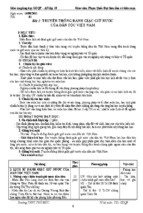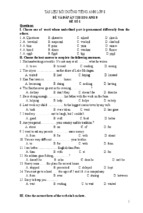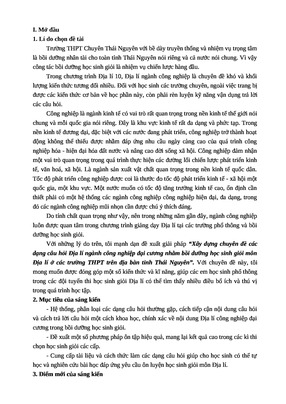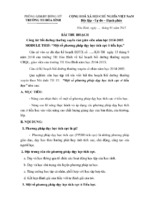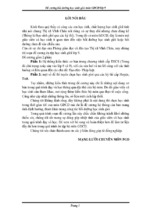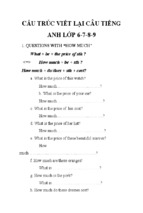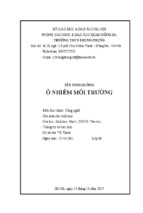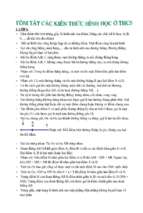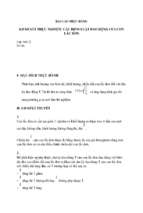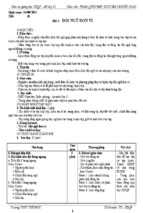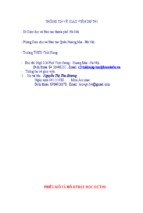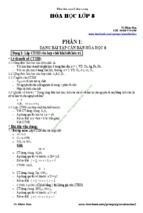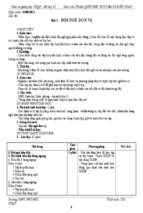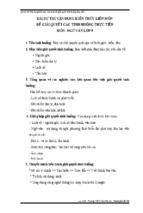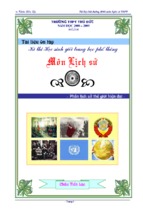Read the following passage and mark the letter A, B, C or D on your answer
sheet to indicate the correct
answer to each of the following questions
BÀI SỐ 1
Animation traditionally is done by hand-drawing or painting successive frames of an
object, each slightly different than the preceding frame. In computer animation, although
the computer may be the one to draw the different frames, in most cases the artist will
draw the beginning and ending frames and the computer will produce the drawings
between the first and the last drawing. This is generally referred to as computer-assisted
animation, because the computer is more of a helper than an originator.
In full computer animation, complex mathematical formulas are used to produce the
final sequence of pictures. These formulas operate on extensive databases of numbers
that define the objects in the pictures as they exist in mathematical space. The database
consists of endpoints, and color and intensity information. Highly trained professionals
are needed to produce such effects because animation that obtains high degrees of realism
involves computer techniques for three-dimensional transformation, shading, and
curvatures.
High-tech computer animation for film involves very expensive computer systems
along with special color terminals or frame buffers. The frame buffer is nothing more
than a giant image memory for viewing a single frame. It temporarily holds the image for
display on the screen.
A camera can be used to film directly from the computer's display screen, but for the
highest quality images possible, expensive film recorders are used. The computer
computes the positions and colors for the figures in the picture, and sends this
information to the recorder, which captures it on film. Sometimes, however, the images
are stored on a large magnetic disk before being sent to the recorder. Once this process is
completed, it is repeated for the next frame. When the entire sequence has been recorded
on the film, the film must be developed before the animation can be viewed. If the entire
sequence does not seem right, the motions must be corrected, recomputed, redisplayed,
and rerecorded. This approach can be very expensive and time consuming. Often,
computer-animation companies first do motion tests with simple computer-generated line
drawings before selling their computers to the task of calculating the high-resolution,
realistic-looking images.
Question 1: What aspect of computer animation does the passage mainly discuss?
A. The production procession
B. The equipment needed
C. The high cost
D. The role of the artist
Question 2: According to the passage, in computer-assisted animation the role of the
computer is to draw the ________.
A. first frame
B. middle frames
C. last frame
D. entire sequences of frames
Question 3: The word "they" in the second paragraph refers to ________
A. formulas
B. objects
C. numbers
D. database
Question 4: According to the passage, the frame buffers mentioned in the third
paragraph are used to ________.
A. add color to the images
time
B. expose several frames at the same
C. store individual images
D. create new
frames
Question 5: According to the passage, the positions and colours of the figures in
high-tech animation are determined ________.
A. drawing several versions
B. enlarging one frame at a lime
C. analyzing the sequence from different angles
D. using computer calculations
Question 6: The word "captures" in the fourth paragraph is closest in meaning to
_______
A. separates
B. registers
C. describes
D. numbers
Question 7: Which of the following statements is supported by the passage?
A. Computers have reduced the costs of animation.
B. In the future, traditional artists will no longer be needed.
C. Artists are unable to produce drawings as high in quality as computer drawings.
D. Animation involves a wide range of technical and artistic skills.
BÀI SỐ 2
In the world today, particularly in the two most industrialized areas, North America
and Europe, recycling is big news. People are talking about it, practicing it, and
discovering new ways to be sensitive the environment. Recycling means finding ways
to used products a second time. The motto of the recycling movement is "Reduce,
Reuse, Recycle".
The first step is to reduce garbage. In stores, a shopper has to buy products in
blister packs, boxes and expensive plastic wrappings. A hamburger from a fast food
restaurant comes in lots of packaging: usually paper, a box, and a bag. All that
packaging is wasted resources. People should try to buy things that are wrapped
simply, and to reuse cups and utensils. Another way to reduce waste is to buy
high-quality products. When low quality appliances break, many customers throw
them away and buy new ones - a loss of more resources and more energy. For
example, if a customer buys a high-quality appliance that can be easily repaired, the
manufacturer receives an important message. In the same way, if a customer chooses
a product with less packaging, that customer sends an important message to the
manufacturers. To reduce garbage, the throwaway must stop.
The second step is to reuse. It is better to buy juices and soft drinks in returnable
bottles. After customers empty the bottles, they return them to the store. The
manufacturers of the drinks collect the bottles, wash them, and then fill them again.
The energy that is necessary to make new bottles is saved. In some parts of the world,
returning bottles for money is a common practice. In those places, the garbage dumps
have relatively little glass and plastic from throwaway bottles.
The third step is being environmentally sensitive is to recycle. Spent motor oil can be
cleaned and used again. Aluminum cans are expensive to make. It takes the same
amount of energy to make one aluminum can as it does to run a color TV set for three
hours. When people collect and recycle aluminum (for new cans), they help save one
of the world's precious resources.
Question 8: Which area is considered one of the most industrialized?
A. South America
B. Middle East
C. Europe
D. Asia
Question 9: What does the word “sensitive” in line 2 means?
A. cautious
B. logical
C. friendly
D. responding
Question 10: The word “motto” is closet in meaning to ________
A. meaning
B. value
C. belief
D. reference
Question 11: It is a waste when customers buy low-quality products because
________
A. they have to be repaired many times.
B. they will soon throw them away
C. customers always change their area
D. they are very cheap
Question 12: What is the topic of the passage?
A. How to live sensitively to the environment.
B. How to reduce garbage disposal.
C. What is involved in the recycling movement.
D. What people understand the term “recycle”
Question 13: People can do the following to reduce waste EXCEPT ________
A. buy high-quality products
B. buy simply-wrapped things
C. reuse cups
D. buy more hamburgers
Question 14: What best describe the process of reuse?
A. The bottles are collected, washed, returned and filled again.
B. The bottles are washed, returned filled again and collected.
C. The bottles are filled again after being returned, collected and washed.
D. The bottles are collected, returned, filled again and washed.
BÀI SỐ 3
A survey is a study, generally in the form of an interview or a questionnaire, which
provides information concerning how people think and act. In the United States, the
best-known surveys are the Gallup poll and the Harris poll. As anyone who watches
the news during presidential campaigns knows, these polls have become an important
part of political life in the United States.
North Americans are familiar with the many "person on the street"
interviews on local television news shows. While such interviews can be highly
entertaining, they are not necessarily an accurate indication of public opinion.
First, they reflect the opinions of only those people who appear at a certain location.
Thus, such samples can be biased in favor of commuters, middle-class shoppers, or
factory workers, depending on which area the new people select. Second, television
interviews tend to attract outgoing people who are willing to appear on the air, while
they frighten away others who may feel intimidated by a camera. A survey must be
based on a precise, representative sampling if it is to genuinely reflect a broad range
of the population.
In preparing to conduct a survey, sociologists must exercise great care
in the wording of questions. An effective survey question must be simple and clear
enough for people to understand it. It must also be specific enough so that there are no
problems in interpreting the results. Even questions that are less structured must be
carefully phrased in order to elicit the type of information desired. Surveys can
be indispensable sources of information, but only if the sampling is done properly and
the questions are worded accurately.
There are two main forms of surveys: the interview and the questionnaire. Each of these forms of survey research has its advantages. An interviewer
can obtain a high response rate because people find it more difficult to turn down a
personal request for an interview than to throw away a written questionnaire.
In addition, an interviewer can go beyond written questions and probe
for a subject's underlying feelings and reasons. However, questionnaires have the
advantage of being cheaper and more consistent.
Question 15: According to the passage, one advantage of live interviews over
questionnaires is that live interviews _________.
A. minimize the influence of the researcher
B. are easier to interpret
C. costless
D. can produce more information
Question 16: The word “they” refers to ________.
A. interviews
B. opinions
C. news shows
D.
North
Americans
Question 17: Which word is given definition in the text?
A. sampling
B. poll
C. survey
D. interview
Question 18: According to paragraph 3, which of the following is most important for
an effective survey?
A. A sociologist who is able to interpret the results
B. Carefully worded questions
C. An interviewer’s ability to measure respondents’ feelings
D. A high number of respondents
Question 19: What does the passage mainly discuss?
A. The principles of conducting surveys
B. The importance of polls in American political life
C. Problems associated with interpreting surveys
D. The history of surveys in North America
BÀI SỐ 4
Basic to any understanding of Canada in the 20 years after the Second World War is
the country’s impressive population growth. For every three Canadians in 1945, there
were over five in 1966. In September 1966 Canada’s population passed the 20 million
mark. Most of his surging growth came from natural increase. The depression of the
1930’s and the war had held back marriages, and the catching-up process began after
1945. The baby boom continued through the decade of the 1950s, producing a
population increase of nearly fifteen percent in the five years from 1951 to 1956. This
rate of increase had been exceeded only once before settle. Undoubtedly, the good
economic conditions of the 1950’s supported a growth in the population, but the
expansion also derived from a trend toward earlier marriages and an increase in the
average size of families. In 1957 the Canadian birth rate stood at 28 per thousand, one
of the highest in the world.
After the peak year of 1957, the birth rate in Canada began to decline. It
continued falling until in 1966 it stood at the lowest level in 25 years. Partly this
decline reflected the low level of births during the depression and the war, but it was
also caused by changes in Canadian society. Young people were staying at school
longer; more women were working; young married couples were buying automobiles
or houses before starting families; rising living standards were cutting down the size
of families. It appeared that Canada was once more falling in step with the trend
toward smaller families that had occurred all through the Western world since the
time of the Industrial Revolution.
Although the growth in Canada’s population had slowed down by
1966 (the increase in the first half of the 1960’s was only nine percent), another large
population wave was coming over the horizon. It would be composed of the children
who were born during the period of the high birth rate prior to 1957.
Question 20: What does the passage mainly discuss?
A. Educational changes in Canadian society
War
B. Canada during the Second World
C. Population trends in postwar Canada
D. Standards of
living in Canada.
Question 21: The word “five” in bold refers to
A. Canadians
B. years
C. decades
D. marriages
Question 22: The word “surging” in bold is closest in meaning to
A. new
B. extra
C. accelerating
D. surprising
Question 23: The author suggests that in Canada during the 1950’s
A. the urban population decreased rapidly
B. fewer people married
C. economic conditions were poor
D. the birth rate was very high
Question 24: The word “trend” in bold is closest in meaning to:
A. tendency
B. aim
C. growth
D. directive
Question 25: The author mention all of the following as causes of declines in
population growth after 1957
EXCEPT
A. people being better educated
B. people getting married earlier
C. better standards of living
D. couples buying houses
Question 26: It can be inferred from the passage that before the Industrial Revolution
A. families were larger
B. population statistics were unreliable
C. the population grew steadily
D. economic conditions were bad
Question 27: The word “it” in bold refers to
A. horizon
B. population wave
C. nine percent
D. first half
BÀI SỐ 5
Shyness may not seem to be a serious complaint, but for some who suffer from it, it
can become unbearable. Even talking to a small group of people you know can seem
like an ordeal - it can feel as if you’ve been asked to give a speech on a topic you know
very little about to a number of experts. You start to feel hot and shaky, your heart beats
faster, your knees feel weak, you begin to stutter and the whole experience seems to last
forever.
The fact of the matter is that shyness is something we often recognize in others:
blushing is one of the more visible signs, for example. Yet we do not judge someone
harshly because of this. But shyness does mean you are harder to approach, so you
become more isolated. As one shy person put it, “It’s like being in a prison, and it’s very
hard to break out.”
Experts on the subject have come up with various possible solutions, and one has
been singled out as being the key to success, namely, finding an interest in common
with other people. Spending a lot of time on the sidelines watching other people and
envying them because they are much more outgoing doesn’t help; remembering that
some of the people you envy most are probably shy themselves. The secret is how you
deal with it. And experts have come up with four things you can do today to help.
Firstly, you can start by listening to other people. You will find yourself getting
interested in what they’re talking about and asking questions, and before you know it,
you’ll be having a conversation. Secondly, you could try asking neighbors if you can
walk their dog. Like children, pets can be excellent icebreakers for conversations with
passers-by. Thirdly, try joining a class to learn something like tap-dancing or flamenco,
where people are likely to laugh a lot. You’ll feel relaxed, and also you’ll be much too
busy concentrating on what you are doing to feel shy. Lastly, try telling yourself that it
doesn’t matter if you say or do something silly. Most people make a fool of themselves
every so often, and it’s not the end of the world if you do.
Question 28. One of the symptoms of shyness in a stressful situation is ________
A. sweating a lot.
B. an increased heart rate.
C. pain in the knees.
D. excessive talkativeness.
Question 29. Why do shy people become more reserved?
A. Their social unease makes them more difficult to talk to.
B. They see that others are shy too.
C. Other people lack the patience to talk to them.
D. They dread being judged by others.
Question 30. The word “blushing” in paragraph 2 is closest in meaning to ________.
A. going green
B. going red
C. smiling
D. sweating
Question 31. What do experts believe is the most essential measure to be taken?
A. Studying others’ behaviour in social situations.
B. Discovering shared interests with others.
C. Comparing yourself to other people.
D. Finding out what makes other people shy.
Question 32. How can listening to others prove helpful in combating shyness?
A. You develop useful psychological skills.
B. It’s the first step to getting into conversation.
C. People will see you care about their interests.
D. It’s a visible sign of becoming less shy.
BÀI SỐ 6
Every drop of water in the ocean, even in the deepest parts, responds to the forces
that create the tides. No other force that affects the sea is so strong. Compared with the
tides, the waves created by the wind are surface movements felt no more than a hundred
fathoms below the surface. The currents also seldom involve more than the upper
several hundred fathoms despite their impressive sweep.
The tides are a response of the waters of the ocean to the pull of the Moon and the
more distant Sun. In theory, there is a gravitational attraction between the water and
even the outermost star of the universe. In reality, however, the pull of remote stars is so
slight as to be obliterated by the control of the Moon and, to a lesser extent, the Sun.
Just as the Moon rises later each day by fifty minutes, on the average, so, in most
places, the time of high tide is correspondingly later each day. And as the Moon waxes
and wanes in its monthly cycle, so the height of the tide varies. The tidal movements are
strongest when the Moon is a sliver in the sky, and when it is full. These are the highest
flood tides and the lowest ebb tides of the lunar month and are called the spring tides. At
these times the Sun, Moon, and Earth are nearly in line and the pull of the two heavenly
bodies is added together to bring the water high on the beaches, to send its surf upward
against the sea cliffs, and to draw a high tide into the harbors. Twice each month, at the
quarters of the Moon, when the Sun, Moon, and Earth lie at the apexes of a triangular
configuration and the pull of the Sun and Moon are opposed, the moderate tidal
movements called neap tides occur. Then the difference between high and low water is
less than at any other time during the month.
Question 33. What is the main point of the first paragraph?
A. The waves created by ocean currents are very large.
B. Despite the strength of the wind, it only moves surface water.
C. Deep ocean water is seldom affected by forces that move water.
D. The tides are the most powerful force to affect the movement of ocean water.
Question 34. The word “felt” in line 3 is closest in meaning to
A. based
B. dropped
C. detected
D. explored
Question 35. The words “In reality” in line 8 are closest in meaning to
A. surprisingly
B. actually
C. characteristically
D. similarly
Question 36. It can be inferred from the passage that the most important factor in
determining how much gravitational effect one object in space has on the tides is
A. size
B. distance
C. temperature
D. density
Question 37 The word “correspondingly” in line 11 is closest in meaning to
A. unpredictably
B. interestingly
C. similarly
D. unusually
Question 38. What is the cause of spring tides?
A. Seasonal changes in the weather
B. The gravitational pull of the Sun and the Moon when nearly in line with the Earth
C. The Earth's movement around the Sun
D. The triangular arrangement of the Earth, Sun, and Moon
BÀI SỐ 7
Centuries ago, man discovered that removing moisture from food helped to
preserve it, and that the easiest way to do this was to expose the food to sun and wind.
In this way the North American Indians produced pemmican (dried meat ground into
powder and made into cakes), the Scandinavians made stock fish and the Arabs dried
dates and apricots.
All foods contain water - cabbage and other leaf vegetables contain as much as
93% water, potatoes and other root vegetables 80%, lean meat 75% and fish anything
from 80% to 60% depending on how fatty it is. If this water is removed, the activity
of the bacteria which cause food to go bad is checked.
Fruit is sun-dried in Asia Minor, Greece, Spain and other Mediterranean
countries, and also in California, South Africa and Australia. The methods used vary,
but in general the fruit is spread out on trays in drying yards in the hot sun. In order to
prevent darkening, pears, peaches and apricots are exposed to the fumes of burning
sulphur before drying. Plums for making prunes, and certain varieties of grapes for
making raisins and currants, are dipped in an alkaline solution in order to crack the
skins of the fruit slightly and remove their wax coating, so increasing the rate of
drying.
Nowadays most foods are dried mechanically; the conventional method of such
dehydration is to put food in chambers through which hot air is blown at temperatures
of about 110°C at entry to about 45°C at exit. This is the usual method for drying such
things as vegetables, minced meat, and fish.
Liquids such as milk, coffee, tea, soups and eggs may be dried by pouring them
over a heated horizontal steel cylinder or by spraying them into a chamber through
which a current of hot air passes. In the first case, the dried material is scraped off the
roller as a thin film which is then broken up into small, though still relatively coarse
flakes. In the second process it falls to the bottom of the chamber as a fine powder.
Where recognizable pieces of meat and vegetables are required, as in soup, the
ingredients are dried separately and then mixed.
Dried foods take up less room and weigh less than the same food packed in cans
or frozen, and they do not need to be stored in special conditions. For these reasons
they are invaluable to climbers, explorers and soldiers in battle, who have little
storage space. They are also popular with housewives because it takes so little time to
cook them.
Question 39: What is the main idea of the passage?
A. Mechanization of drying foods
C. Advantages of dried foods
B. Water, the main component of food
D. Different methods of drying foods.
Question 40: The word “checked” in the second paragraph is closest in meaning to
________.
A. put a tick
B. reduced considerably
C. motivated to develop
D. examined carefully
Question 41: In the process of drying certain kinds of fruits, sulphur fumes helps
________.
A. crack the skin
B. kill of bacteria
C. remove the wax coating
D. maintain the color
Question 42: According to the passage, dried foods are most useful for ________.
A. people who are on the move
B. explores who are underweight
C. housewives who have little storage space
D. soldiers who are not in battle.
Question 43: This passage is mainly ________.
A. informative
B. fictional
C. argumentative
Question 44: We prefer going by train because we can enjoy the sight.
A. We would like to go by train, or we will enjoy the sight.
B. We enjoy the sight although we go by train.
C. We prefer going by train to enjoying the sight.
D. We would like to go by train so that we can enjoy the sight.
Question 45: The airport taxes are included in the ticket price.
A. You need to pay for ticket and airport taxes.
B. The ticket is included in the airport taxes.
C. The ticket price includes the airport taxes.
D. The airport taxes and ticket price should be paid separately.
Question 46: The researchers finalized their research methods.
A. The researchers chose the last research methods.
B. The researchers made the final decision on their research methods
C. Research methods are decided at the final stage of the study.
D. anal ytical
D. The researchers saved research methods for the final part.
Question 47: We always find Robert’s stories amusing.
A. Robert’s amusing stories are found.
B. Robert always interested in amusing stories.
C. We are always amused by Robert’s stories.
D. We always find Robert reading amusing stories.
Question 48: The secretary was upset because she was fired.
A. The secretary was unhappy as she lost her job.
B. The secretary was so angry that she set fire to the office.
C. The job was upsetting that the secretary gave it up.
D. The fire was so devastating that the secretary was upset.
BÀI SỐ 8
Plants and animals will find it difficult to escape from or adjust to the effect of global
warming. Scientists have already observed shifts in the lifecycles of many plants and
animals, such as flowers blooming earlier and birds hatching earlier in the spring.
Many species have begun shifting where they live or their annual migration patterns
due to warmer temperatures. With further warming, animals will tend to migrate
toward the poles and up mountainsides toward higher elevations. Plants will also
attempt to shift their ranges, seeking new areas as old habitats grow too warm. In
many places, however, human development will prevent these shifts. Species that find
cities or farmland blocking their way north or south may become extinct. Species
living in unique ecosystems, such as those found in polar and mountaintop regions,
are especially at risk because migration to new habitats is not possible. For instance,
polar bears and marine mammals in the Arctic are already threatened by dwindling
sea ice but have nowhere farther to go. Projecting species extinction due to global
warming is extremely difficult. Some scientists have estimated that 20 to 50 percent
of species could be committed to extinction with 2 to 3 Celsius degrees of further
warming. The rate of warming, not just the magnitude, is extremely important for
plants and animals. Some species and even entire ecosystems, such as certain types of
forest, many not be able to adjust quickly enough and may disappear. Ocean
ecosystems, especially fragile ones like coral reefs, will also be affected by global
warming. Warmer ocean temperatures can cause coral to “bleach”, a state which if
prolonged will lead to the death of the coral. Scientists estimate that even 1 Celsius
degree of additional warming could lead to widespread bleaching and death of coral
reefs around the world. Also, increasing carbon dioxide in the atmosphere enters the
ocean and increases the acidity of ocean waters. This acidification further stresses
ocean ecosystems.
From “global warming” by Michael Mastrandrea and Stephen H.Schneider
Question 49: Scientists have observed that warmer temperatures in the spring cause
flowers to ________.
A. bloom earlier
B. die instantly
C. become lighter
D. lose color
Question 50: According to paragragh 2, when their habitats grow warmer, animals
tend to move ________.
A. toward the North Pole and down mountainsides toward lower elevations.
B. toward the poles and up mountainsides toward higher elevations.
C. south-eastwards and up down mountainsides toward lower elevations.
D. north-westwards and up mountainsides toward higher elevations.
Question 51: The pronoun “those” in paragragh 2 refers to ________.
A. areas
B. habitats
C. species
D. ecosystems
Question 52: The phrase “dwindling sea ice” in paragraph 2 refers to _______.
A. the cold ice in the Arctic
B. the violent Arctic Ocean
C. the melting ice in the Arctic
D. the frozen water in the Arctic
Question 53: It is mentioned in the passage that if the global temperature rose by 2 or
3 Celsius degrees ________.
A. half of the earth’s surface would be flooded
B. water supply would decrease by 50 percent
C. the sea level would rise by 20 centimeters
D. 20 or 50 percent of species could become extinct.
Question 54: According to the passage, if some species are not able to adjust quickly
to warmer temperatures, ________.
A. they will certainly need water
B. they can begin to develop
C. they may be endangered
D. they move to tropical forests.
Question 55: The word “fragile” in paragragh 4 most probably means_______.
A. pretty hard
B. easily damaged
C. rather strong
D. very large
Question 56: The bleaching of coral reefs as mentioned in paragraph 4 indicates
________.
A. the slow death of coral reefs
B. the blooming phase of sea weeds
C. the quick growth of marine mammals
D. the water absorption of coral reefs
Question 57: The level of acidity in the ocean is increased by ________.
A. the loss of acidity in the atmosphere around the earth
B. the decrease of acidity of the pole waters
C. the extinction of species in coastal areas
D. the rising amount of carbon dioxide entering the ocean.
Question 58: What does the passage mainly discuss?
A. Influence of climate changes on human lifestyles.
B. Effects of global warming on animals and plants.
C. Global warming and possible solutions.
D. Global warming and species migration.
BÀI SỐ 9
Long ago prehistoric man began to domesticate a number of wild plants and
animals for his own use. This not only provided a more abundant food source but also
allowed more people to live on a smaller plot of ground. We tend to forget that all
of our present – day pets, livestock, and food plants were taken from the wild and
developed into the forms we know today.
As centuries passed and human cultures evolved anf blossomed, humans
began to organise their knowledge of nature into the broad field of natural history.
One aspect of early natural history concerned the use of plants for drugs and
medicine. The early herbalists sometimes overworked their imaginations in this
respect. For example, it was widely believed that a plant or part of a plant that
resembles an internal organ would cure ailments of that organ. Thus, an extract made
from a heart-shaped leaf might be prescribled for a person suffering from
heart
problems.
Nevertheless, the overall contributions of these early observers provided the
rudiments of our present knowledge of drugs and their uses.
Question 59: What does this passage mainly discuss?
A. Cures from plants
B. The beginning of natural history
C. Prehistoric man
D. Early plants of animals
Question 60: Domestication of plants and animals probably occurred because
of_________.
A. the need for more readily a vailable food
B. lack of wild animals and plants
C. early man’s power as a hunter
D. the desire of prehistoric man to be
nomadic
Question 61: The word “This” in the frist paragraph refers to _____________.
A. providing food for man
animals
B. man’s domestication of plants and
C. man’s ability to live on a small plot of land D. the eariest
condition of prehistoric man
Question 62: The word “blossomed” in the second paragraph is closest in meaning
to_____.
A. produced flowers
B. changed
C. learned
D. flourished
Question 63: An herbalist is which of the following?
A. A dreamer
B. An early historian
C. Someone who uses plants in medicine
D. A farmer
BÀI SỐ 10
In the world to day, particularly in the two most “industrialized areas, North America
and Europe, recyling is big news. People are talking about it, practicing it, and
discovering new ways to be sensitive to the environment. Recycling means finding
was to use products a second time. The motto of the recycling movement is “Reduce,
Reuse, Recycle”.
This first step is to reduce garbage. In stores, a shopper has to buy products in blister
packs, boxes and expensive plastic wrappings. A hamburger form a fast food
restaurant comes in lots of packaging: usually paper, a box, a bag. All that packaging
is wasted resources. People should try to buy things that are wrapped simply, and to
reuse cups and utensils. Another way to reduce waste is to buy high-quality products.
When low quality appliances break, many customers throw them away and buy new
ones – a loss of more resources and more energy. For example, if a customer buys a
high-quality appliance that can be easily repaired, the manufacturer receives an
important message. In the same way, if a customer chooses a product with less
packaging, that customer sends an important message to the manufacturers. To reduce
garbage, the throwaway must stop.
The second step is to reuse. It is better to buy juices and soft drinks in returnable
bottles. After customers empty the bottles, they return them to the store. The
manufacturers of the drinks collect the bottles, wash them, and then fill them again.
The energy that is necessary to make new bottles is saved. In some parts of the word,
returning bottles for money is a common practice. In those places, the garbage dumps
have relatively little glass and plastic from throwaway bottles.
The third step is being environmentally sensitive is to recycle. Spent motor oil can be
cleaned and used again. Aluminum cans are expensive to make. It takes the same
amount of energy to make one aluminum can as it does to run a color TV set for three
hours. When people collect and recycle aluminum (for new cans), they help save one
of the world’s precious resources.
Question 64: What is the main topic of the passage?
A. How to reduce garbage disposal
B. What people often understand about the term “recycle”
C. What is involved in the recycling movement
D. How to live sensitively to the environment
Question 65: People can do the following to reduce waste EXCEPT:
A. buy high-quality product
B. buy simply-wrapped things
C. reuse cups
D. buy fewer hamburgers
Question 66: Why is it a waste when customers buy low-quality products?
A. Because people will soon throw them away.
B. Because they have to be repaired many times.
C. Because customers change their ideas all the time.
D. Because they produce less energy.
Question 67: What best describes the process of reuse?
A. The bottles are collected, washes, returned and filled again.
B. The bottles are filled again after being returned, collected and washed.
C. The bottles are washed, returned filled again and collected.
D. The bottles are collected, returned filled again and washed.
Question 68: What are the two things mentioned as example of recycling?
A. Aluminum cans and plastic wrapping.
B. Hamburger wrappings and spent motor oil.
C. Aluminum cans and spent motor oil.
D. TV sets and aluminum cans.
BÀI SỐ 11
Telecommuting is some form of computer communication between employees’homes
and offices. For employees whose job involve sitting at a terminal or word processor
entering data or typing reports, the location of the computer is of no consequence. If
the machine can communicate over telephone lines, when the work is completed,
employees can dial the office computer and transmit the material to theiremployer. A
recent survey in USA Today estimates that there are approximately 8,7 million
telecommuters. But although the numbers are rising annually, the trend does not
appear to be as significant as predicted when Business Week published “ The Portable
Executive” as its cover story a few years ago. Why hasn’t telecommuting become
more popular?
Clearly, change simply takes time. But in addition, there has been active
resistance on the part of many managers. These executives claim that supervising the
telecommuters in a large work force scattered across the country would be too
difficult, or, at least, systems for managing them are not yet developed, thereby
complicating the manager’s responsibilities.
It is also true that employees who are given the option of telecommuting are
reluctant to accept the opportunity. Most people feel that they need regular interaction
with a group, and many are concerned that they will not have the same consideration
for advancement if they are not more visible in the office setting. Some people feel
that even when a space in their homes is set aside as a work area, they never really get
away from the office.
Question 69: With which of the following topics is the passage primarly concerned?
A. The advantages of telecommuting.
B. A definition of telecommuting.
C. An overview of telecommuting.
D. The failure of telecommuting.
Question 70: The phrase “ of no consequence” means___________.
A. of no use
B. of no good
C. unimportant
D. . irrelevant
- Xem thêm -


